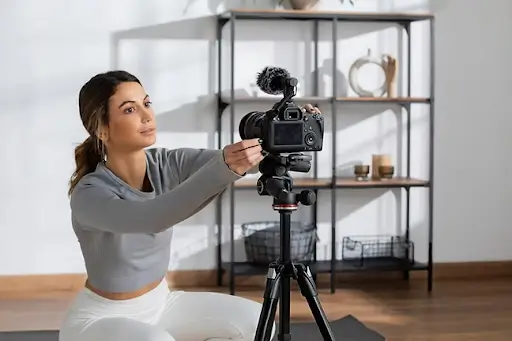Creating high-quality product videos takes more than just pressing a record button. Professional Product video production requires you to be skilled in camera movement, lighting control, sound design, and video editing. Unlike photography, where a single frame tells the story, videography demands fluid motion, engaging transitions, and a deep understanding of visual storytelling.
The catch? Learning these skills often means enrolling in pricey courses.
On top of that, high-end cameras, professional lighting, props, backdrops, and advanced editing software can quickly add up, making the process even more expensive. Let’s be real, all of this can make learning videography feel overwhelming (not to mention over-budget). So how do you sharpen your skills without breaking the bank? That’s exactly what this blog is here to help with. Get ready to level up your videography game while making smart, budget-friendly equipment choices. Let’s get straight into it!
Budget-Friendly Ideas and Resources
1. Leverage Free and Affordable Tools
Cameras: Don’t have the budget for professional cameras? No problem. Modern smartphones like the iPhone or Samsung Galaxy have incredible video capabilities such as 4K/8K recording, advanced image stabilization, and high-frame-rate slow-motion capture, often rivaling professional-grade cameras.
Editing Software: Free options like DaVinci Resolve, HitFilm Express, and iMovie have amazing features, such as advanced color grading, multi-layer editing, user-friendly interfaces, audio adjustments, and VFX. For something more advanced but still affordable, try Adobe Premiere Pro or Final Cut Pro (especially if you’re committed to producing videos long-term).
Lighting Equipment: You can use natural light for shooting. Place your set up near the window or completely outdoors. If you need artificial lighting, inexpensive options like ring lights or clip-on LED panels can improve quality without the hefty price tag.
Tripods and Stabilizers: To avoid shaky footage, invest in a basic smartphone tripod or a handheld gimbal. Both are available for affordable options.
2. Online Training
You don’t need to enroll in an expensive film school to learn the basics of video production. The internet is overflowing with free and low-cost resources taught by experts. Whether you want to improve your product photography or videography, here are the details:
YouTube Tutorials: Channels like Peter McKinnon, Film Riot, and Think Media offer valuable content covering everything from shooting to editing to storytelling.
Online Courses: Platforms like Skillshare, Coursera, or Udemy offer budget-friendly courses with step-by-step tutorials on creating professional-looking videos.
Blogs and Guides: Many blogs—including HubSpot and Wistia—publish comprehensive guides on DIY video production.
Investing a few hours in learning can drastically improve your skills, even if you’re starting from scratch.
3. Use Free Music and Stock Resources
Adding music and stock visuals to your product videos can increase the quality, but paying hefty amounts of licensing fees can be overwhelming. Fortunately, there are many free and affordable resources available:
Music Platforms: Platforms such as Free Music Archive and Epidemic Sound offer a wide selection of music tracks for video backgrounds. While some require a subscription, others provide free options with proper attribution.
Stock Footage: Websites like Pexels, Pixabay, and Mixkit provide high-quality stock videos that can be used in commercial projects at no cost.
It’s essential to review the licensing terms on each platform to make sure you’re using assets legally and avoid copyright issues.
4. Collaboration
Collaboration can give you an access to high-quality resources without a significant budget. Consider reaching out to aspiring filmmakers, photographers, or influencers who may be interested in partnering for mutual benefit. You can offer to feature their work or skills in your video projects in exchange for high-quality content, such as b-roll footage, camera work, or social media exposure, at little to no cost.
Creative Tips for Skill Development
1. Start with Simple Projects
When you’re first starting out, focus on creating simple, short videos for your products. For instance:
-
A 30-second overview of your product.
-
A close-up of its best features with a voiceover.
-
A customer testimonial video.
Keeping things simple early on allows you to practice foundational skills, such as framing, lighting, and editing, without feeling overwhelmed.
2. Storytelling
Every successful videography content has a compelling story. Instead of focusing solely on the features of your product, think about its impact on the lives of your customers. Ask yourself:
-
How does this product solve a problem?
-
What emotions or aspirations does it tap into?
Start scripting your videos with clarity. A strong storyline doesn’t require a massive budget—it requires empathy and creativity.
3. Experiment with Angles and Perspectives
Make your videos more engaging by experimenting with various camera angles and perspectives:
-
Use close-ups to highlight textures or intricate details.
-
Capture medium shots to show the product in use.
-
Add dynamic movement by using slow pans or zooms.
These techniques can make your visuals stand out without needing fancy equipment.
4. Practice Lighting Techniques
Lighting is the key element of the product video. Here are some beginner-friendly tips:
-
Opt for “soft lighting” by diffusing light sources with a white sheet or reflector.
-
Always keep the key light (your main light source) at a 45-degree angle from your subject for a flattering effect.
Keep experimenting with different setups until you find the one that complements your product.
5. Learn by Recreating
One of the best ways to develop video production skills is by observing and recreating. Watch product videos from successful brands in your industry and try to mimic their techniques—lighting, transitions, or even music. Over time, you’ll adopt industry-standard practices and make them your own.
6. Ask for Feedback
Don’t hesitate to share your video drafts with friends, colleagues, or even your followers for constructive feedback. Platforms like Instagram Stories or Facebook polls are excellent tools to gauge audience reactions. Feedback speeds up your learning process and ensures your final videos resonate more with potential customers.
To Wrap Up
Product Video Production is all about starting small, experimenting, and learning as you go. Don’t be discouraged by initial challenges—every video you create will teach you something new. Take advantage of the free tools, training, and creative resources available, and focus on developing your unique style that resonates with your audience. Most importantly, have fun with the process!


